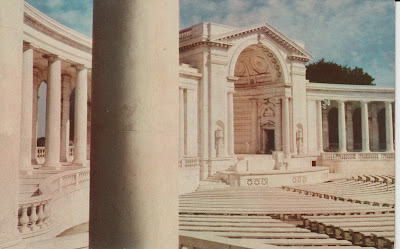The Arlington Memorial Amphitheatre, Arlington Cemetery, VA
[photo by: Richard G.
Gilbert]
This unused MIRRO-KROME postcard distributed by H.S. Crocker Co., Inc. of San Francisco, California, was another card in the batch shared by friends K & J. The code UN-44 is found at the upper left corner on the reverse. MIRRO-KROME was the postcard trademark of H.S. Crocker Co., Inc. from 1950 to 2002. It expired in 2003 when it was not renewed. Just looking at the color on the postcard it is possible to guess that it was issued in the 1950s. The photograph is credited to Richard G. Gilbert.
The picture is of the Arlington Memorial Amphitheater located in the Arlington National Cemetery, Arlington County, Virginia. It is an outdoor amphitheater, exhibit hall and chapel. Designed in 1913 and built between 1915 and 1920 as a larger replacement the older, wooden amphitheater built in 1873 near Arlington House that was renamed Tanner Amphitheater. The photo shows only a portion of the newer elliptical structure. In the center of the eastern steps is the Tomb of the Unknowns. Veteran’s Day and Memorial Day services as well as memorial services and funerals are held at this site.
The Amphitheater has been expanded and renovated several times in the intervening years. In 1998 the remains of a Vietnam War unknown were exhumed and DNA tested. United States Air Force 1st Lieutenant Michael Blassie was identified. That resulted in a marble slab with “Honoring and Keeping Faith with America’s Missing Servicemen” being placed over the then empty grave. The most recent renovation was in 2012.
Thanks as always to K & J for sharing the postcards.
For additional information, see:
https://en.wikipedia.org/wiki/Arlington_Memorial_Amphitheater
https://trademarks.justia.com/716/10/mirro-krome-71610006.html











